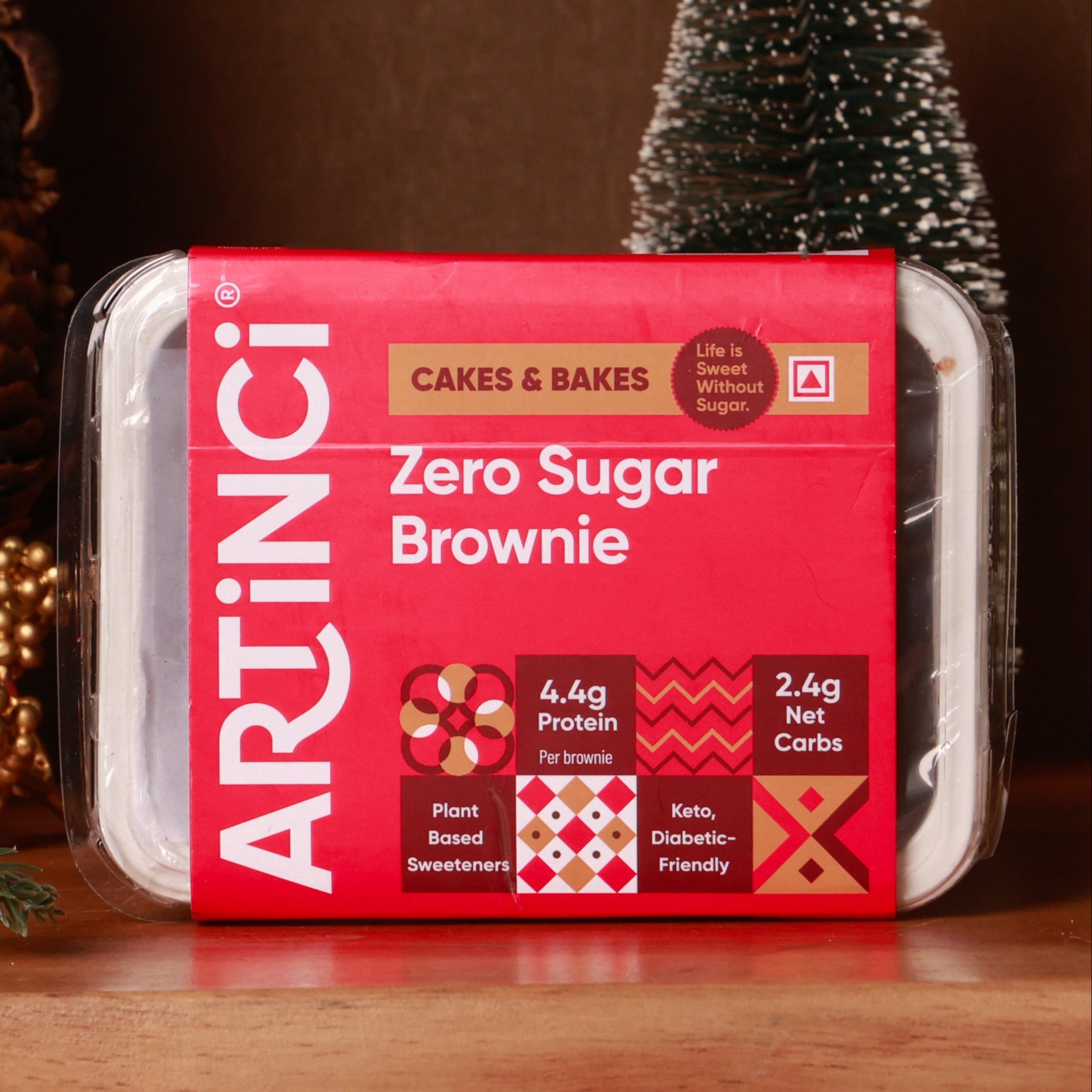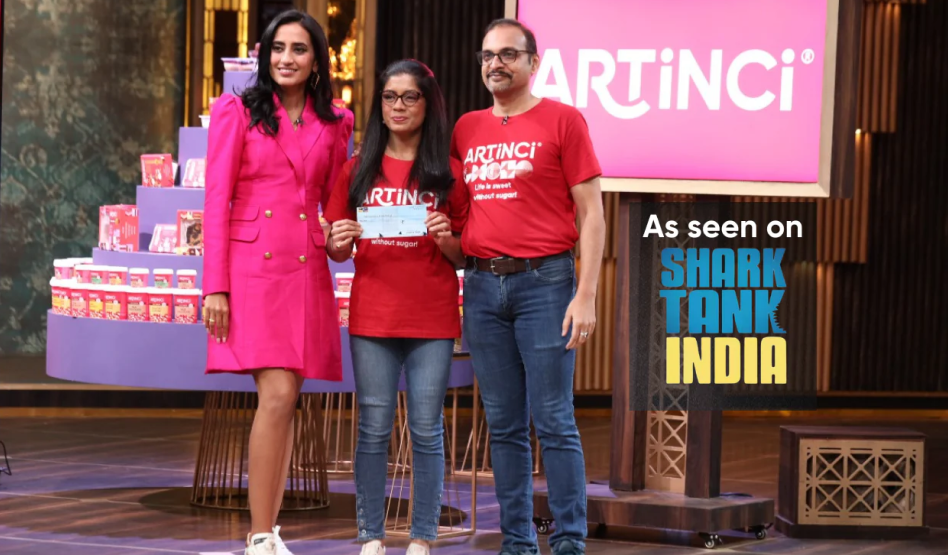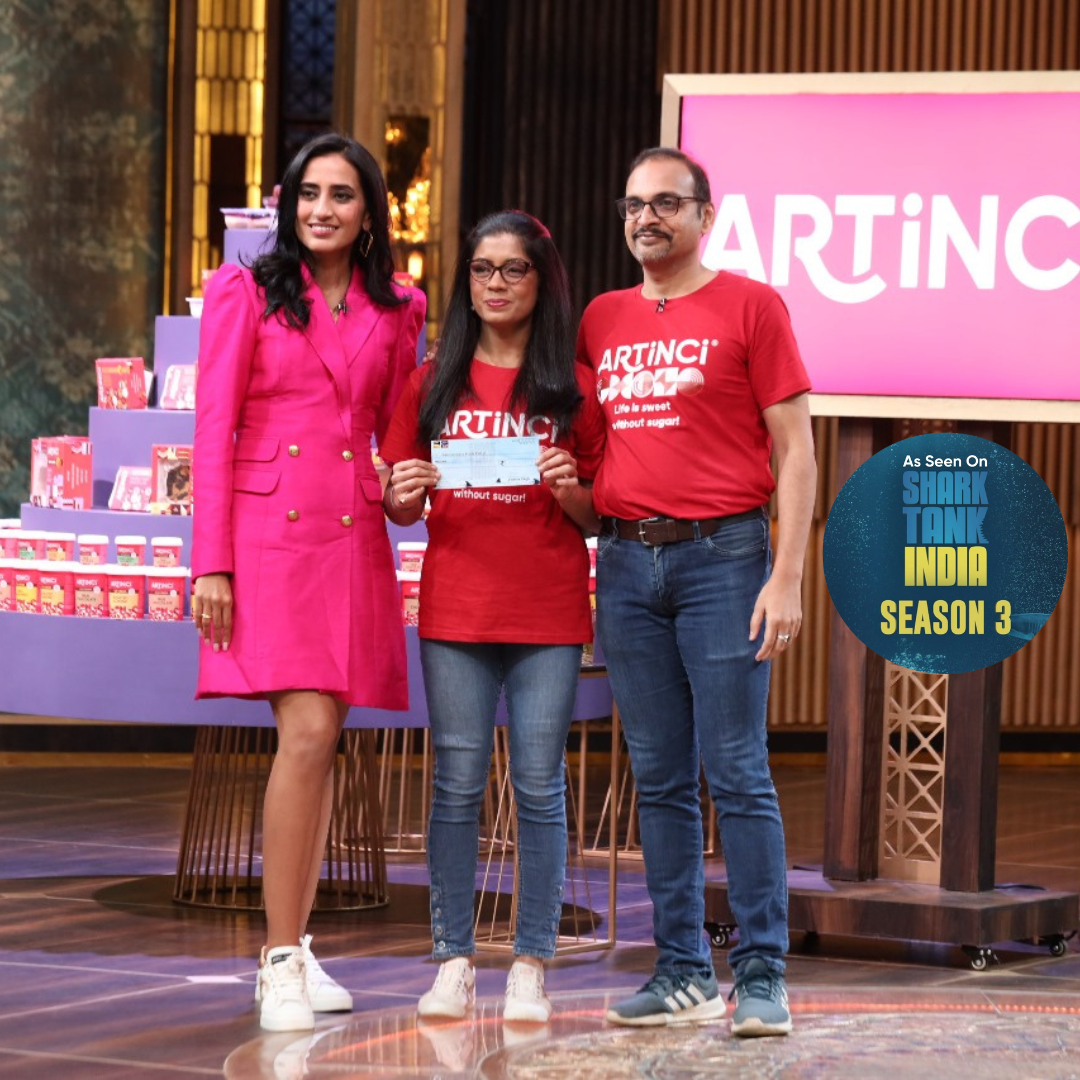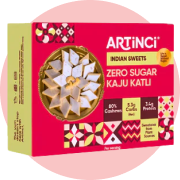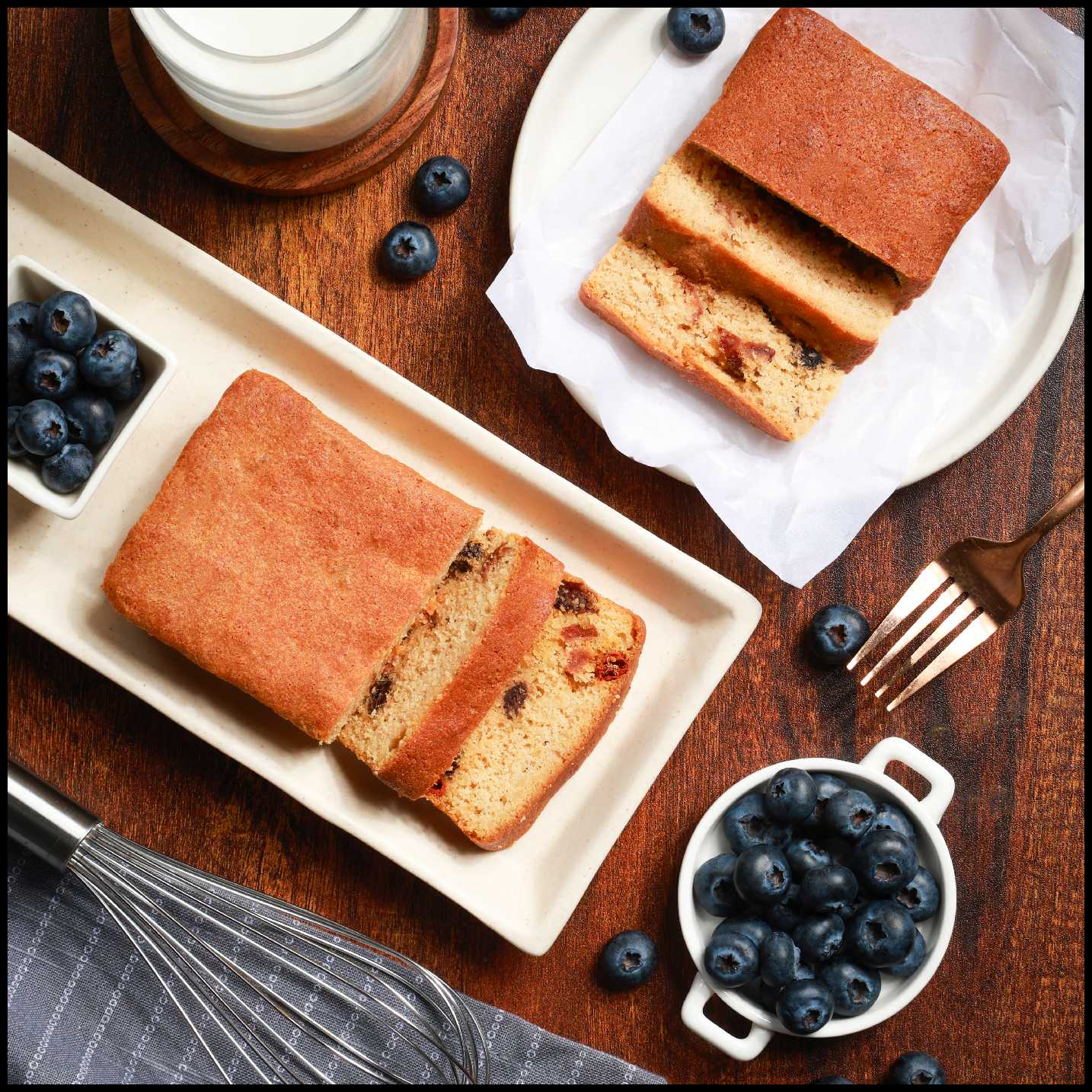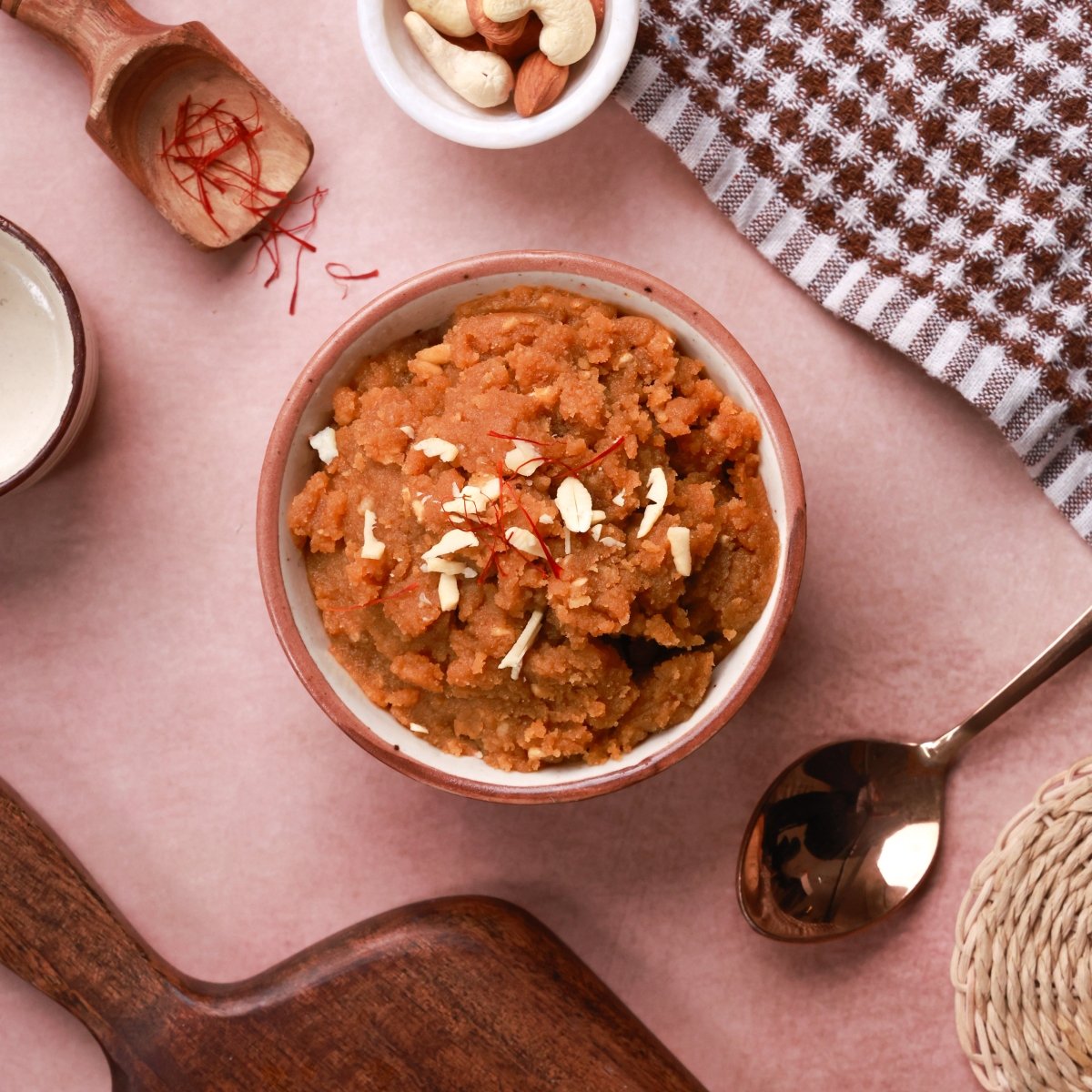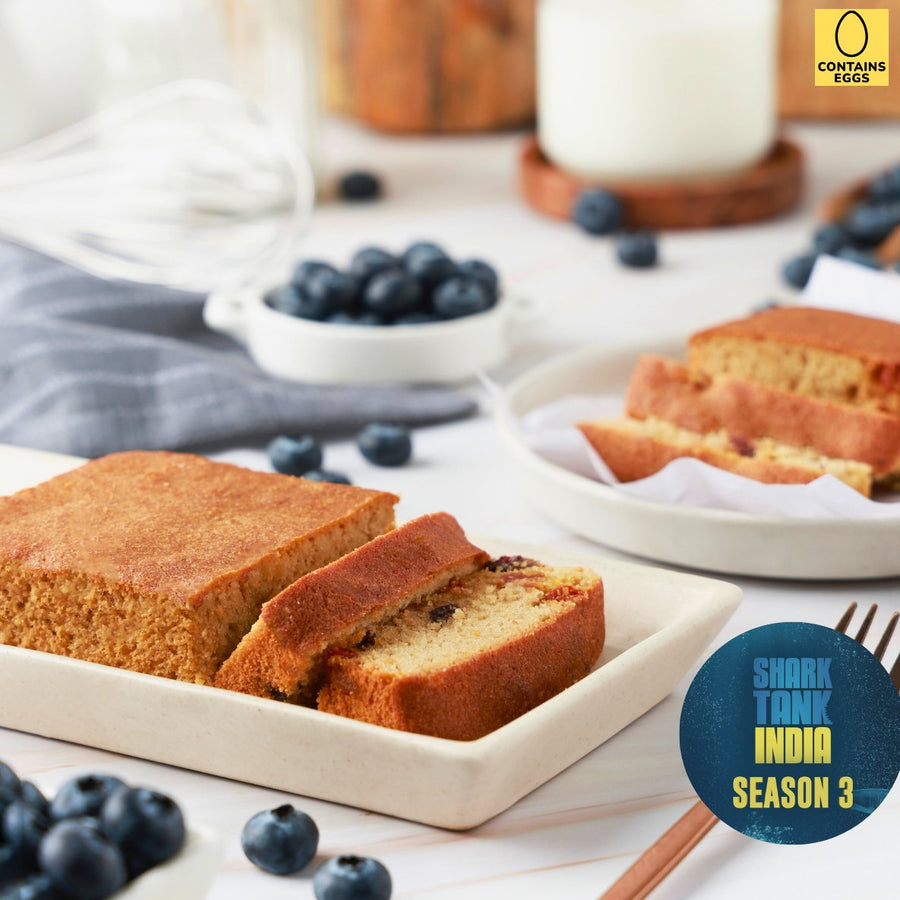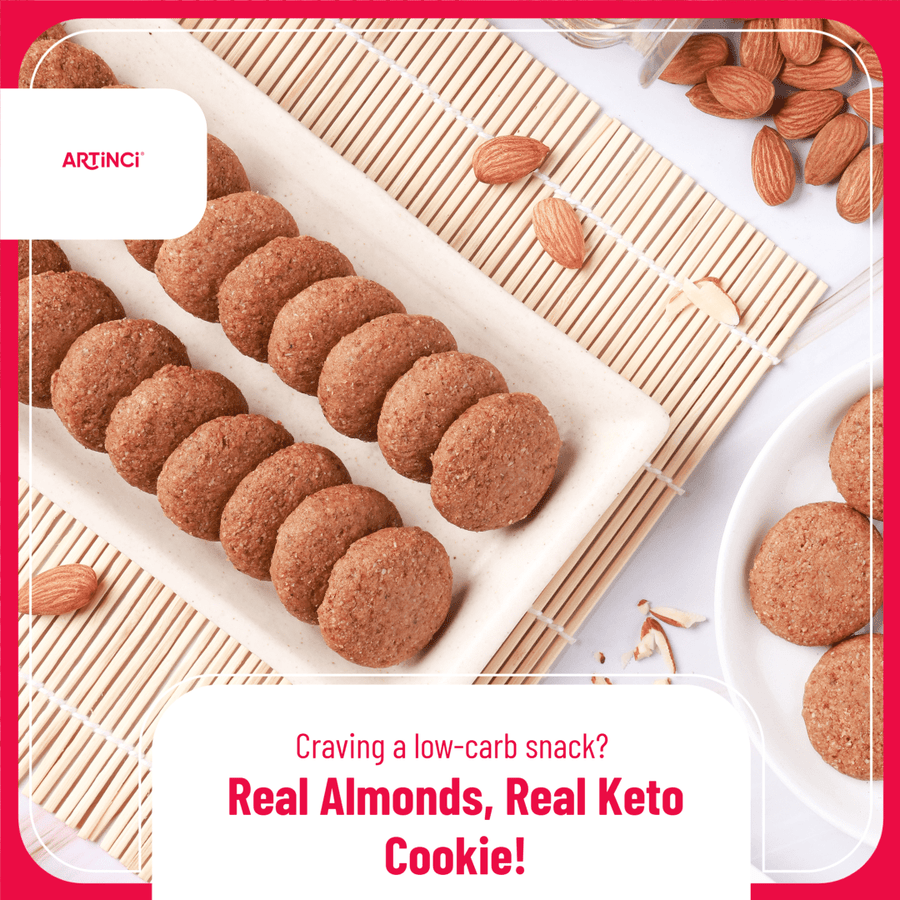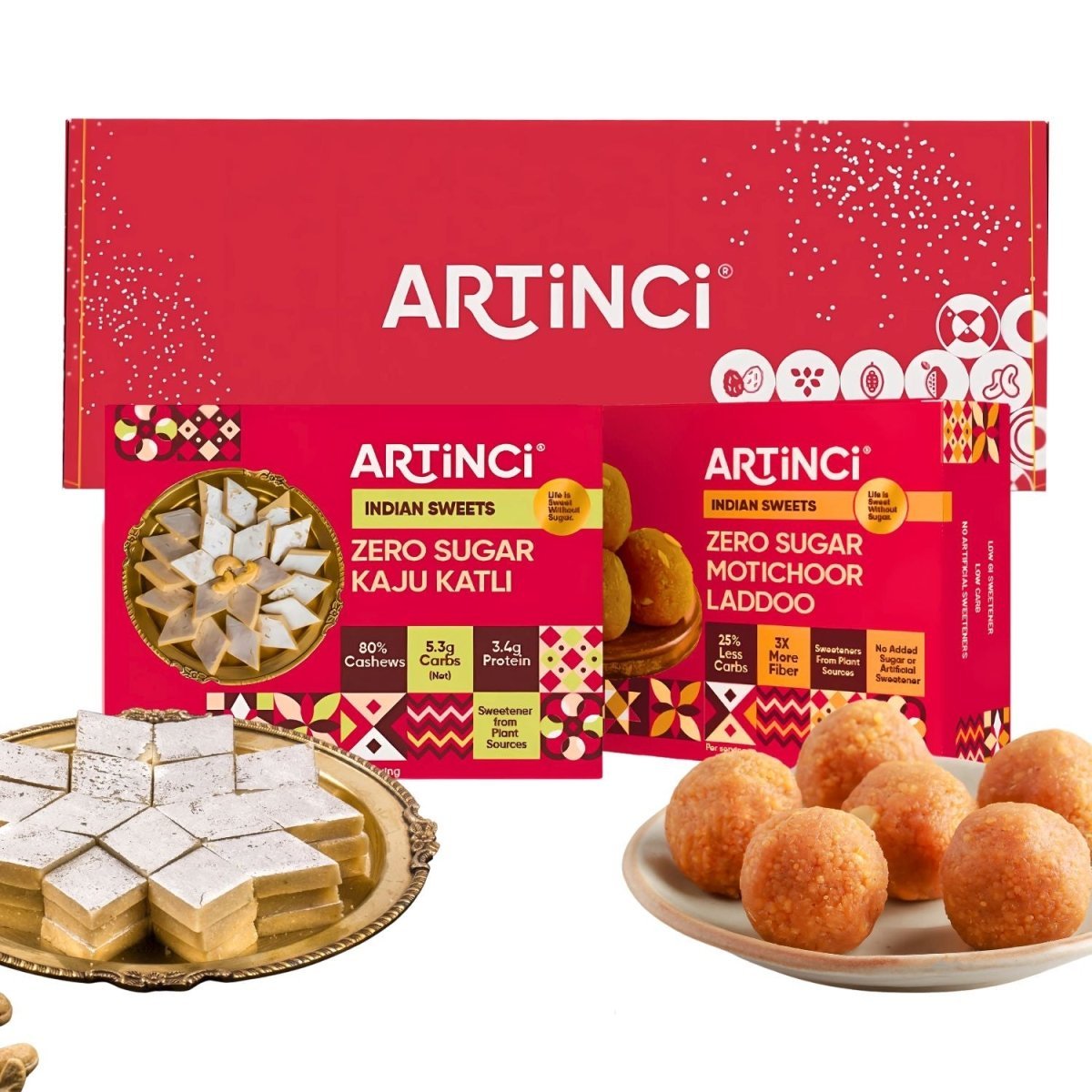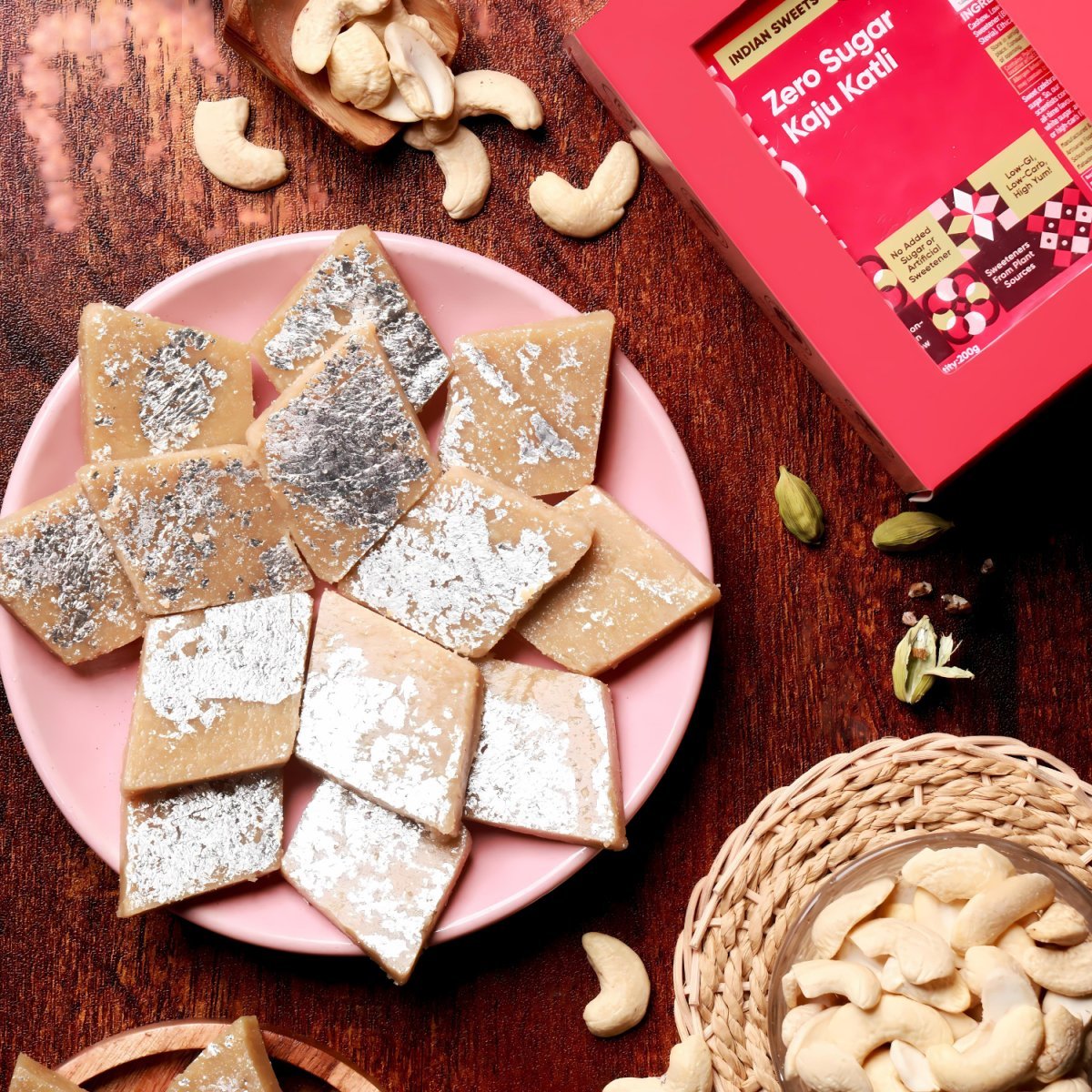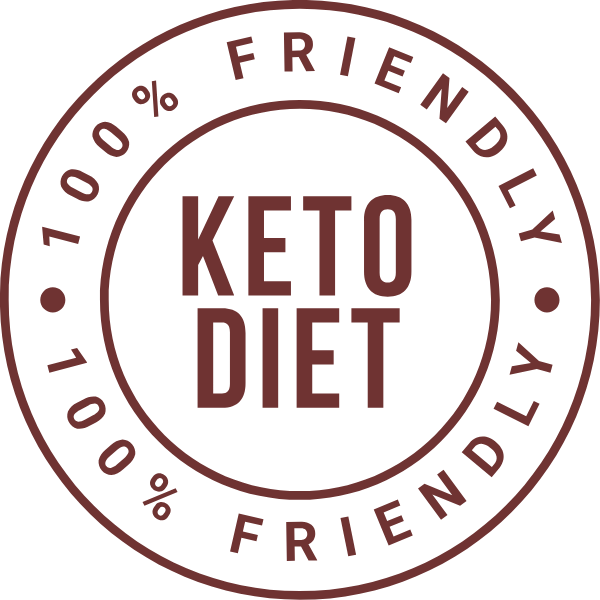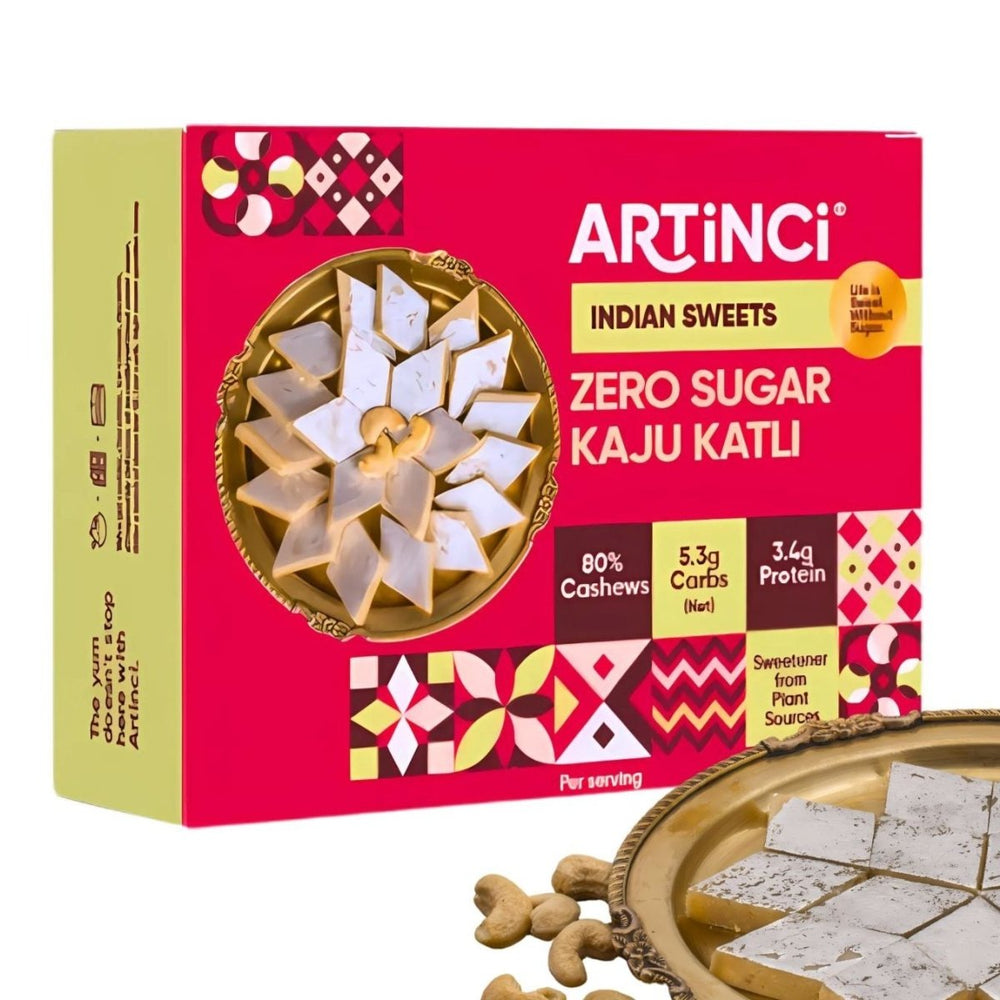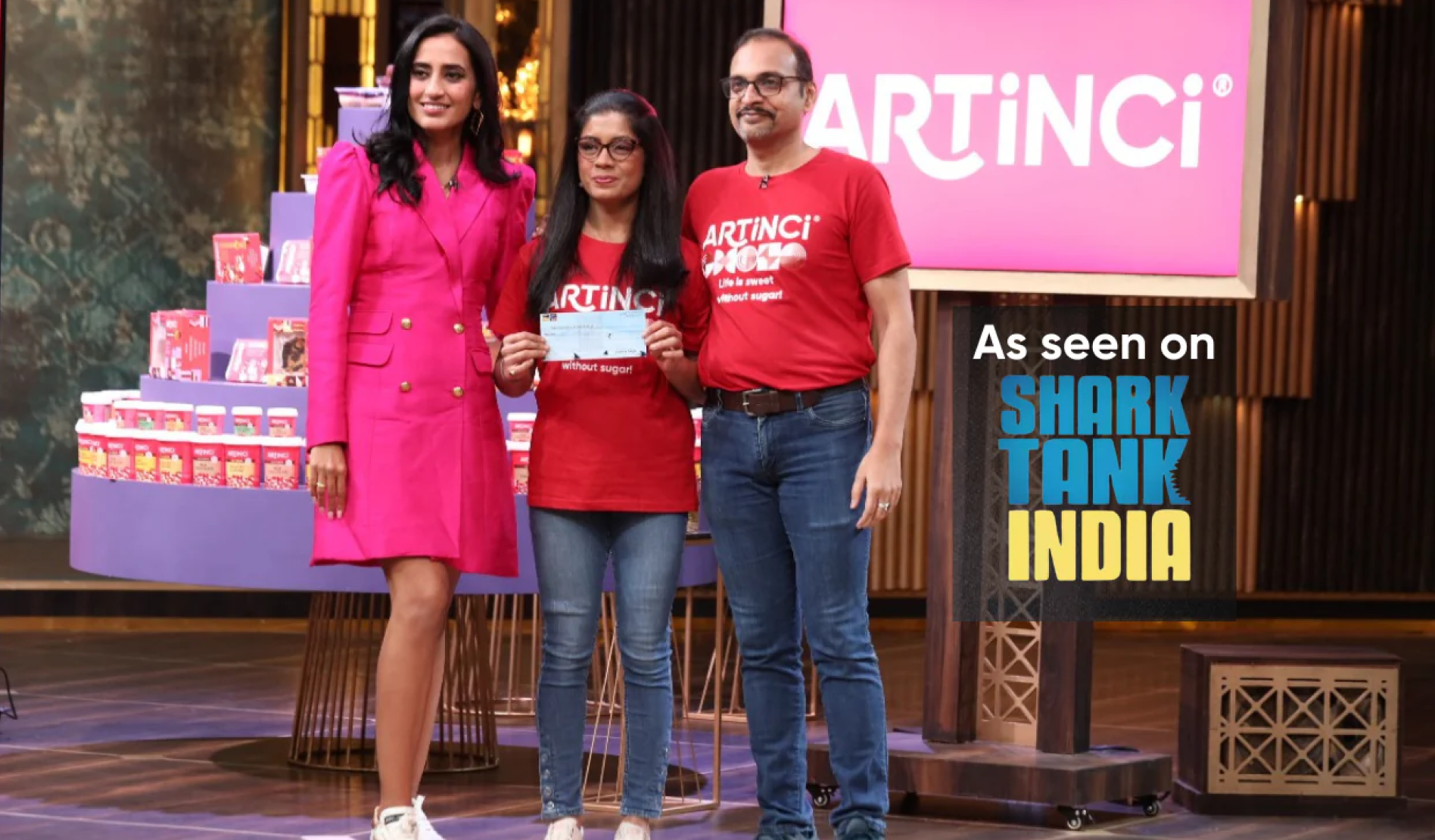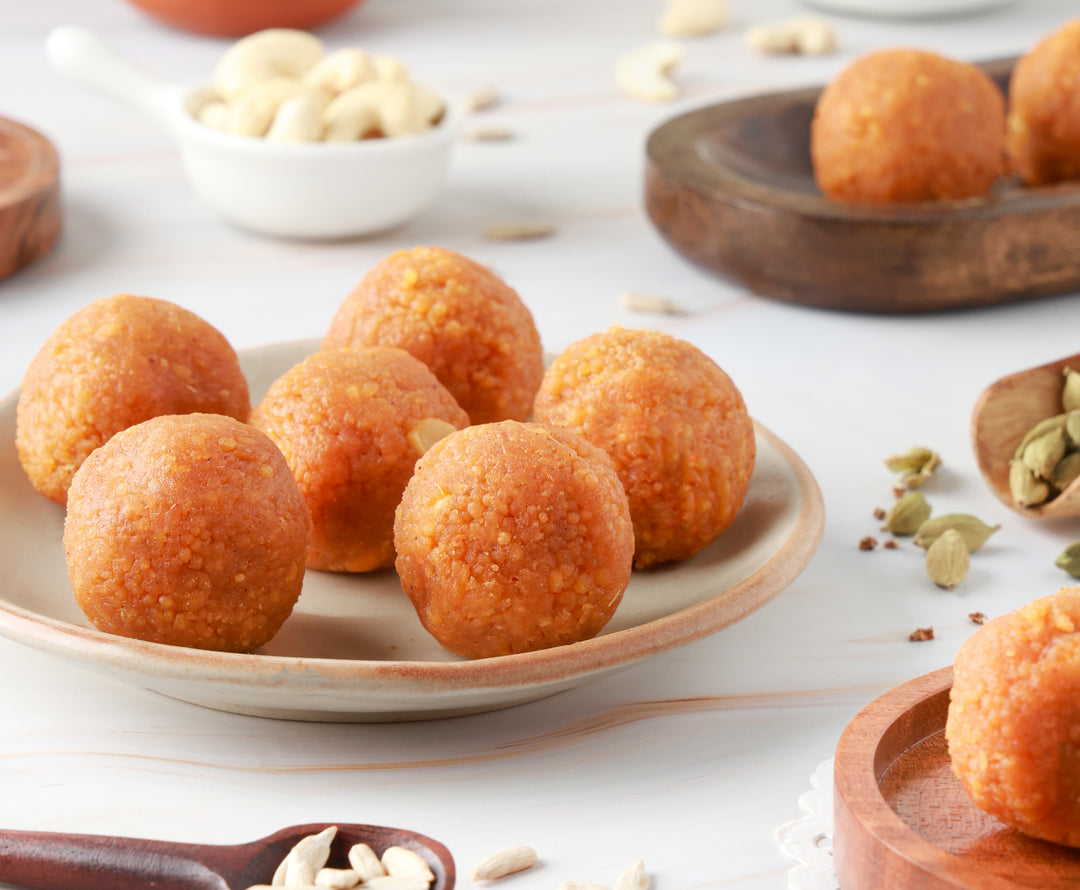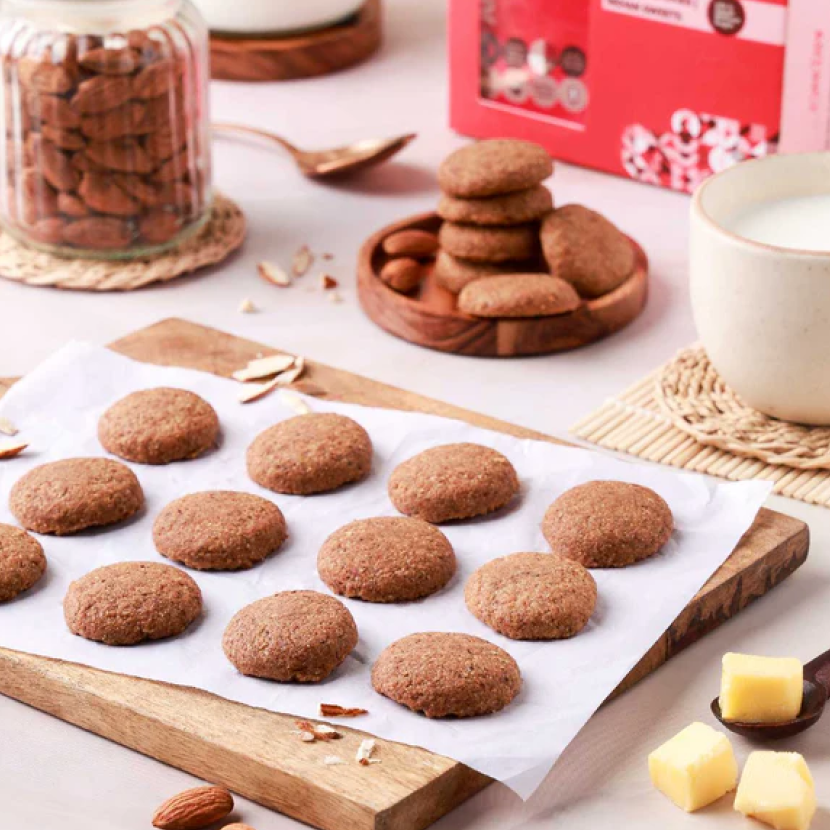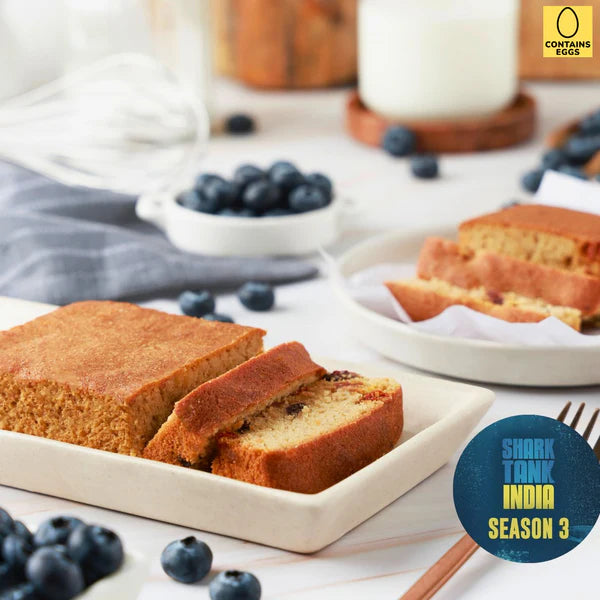Welcome to the world of sugar free joy!
Low Carb Sugar-Free Desserts & Snacks
Artinci was born out of Aarti's and Sumit's (Artinci's founders) abiding love for great-tasting dessert, while helping them stay committed to their health goals as well. As a result, Artinci makes delicious desserts with zero sugar, that are science and evidence-backed.
Aarti and Sumit come from a family of three generations of diabetics. They were themselves diagnosed pre-diabetic in 2012, and right there began a lifelong quest of a healthy, active lifestyle, including healthy swaps in food
Indulgent Halwas & Cozy Cakes


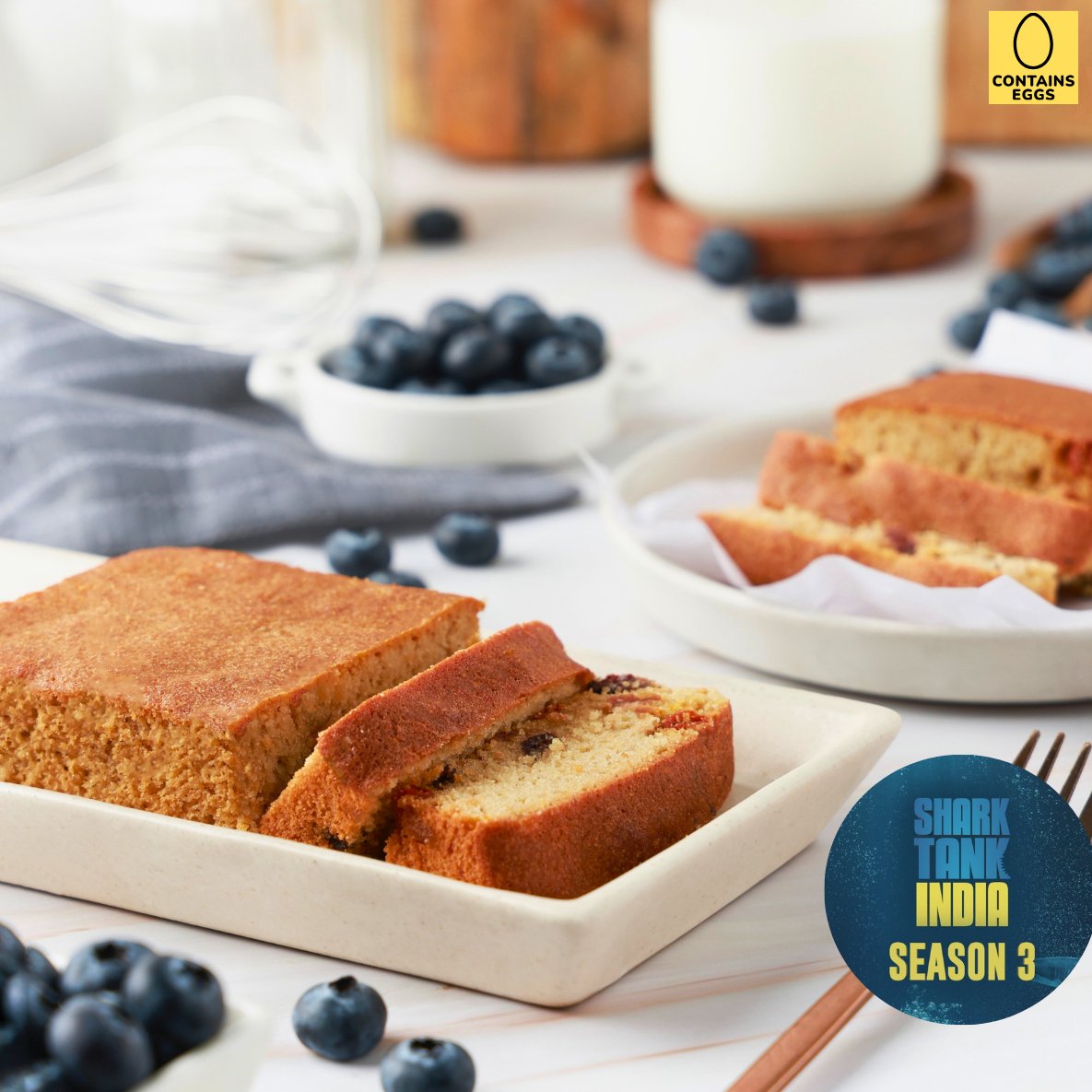
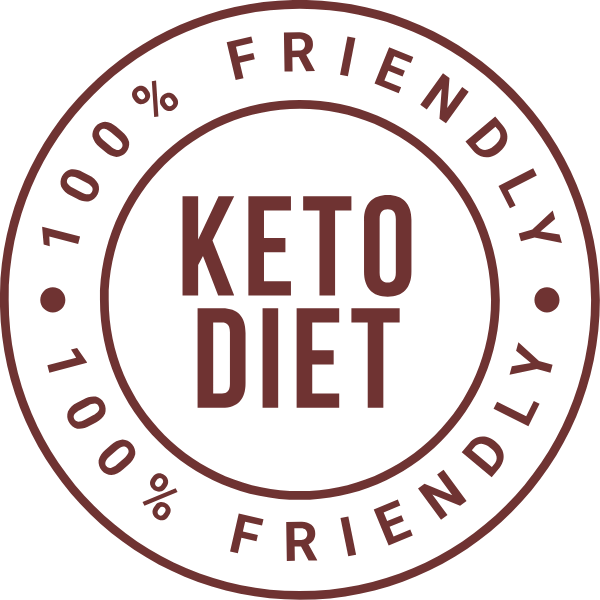

Berries Almond Cake - Made with 100% Almond Flour, Sugar Free, Keto, Gluten Free

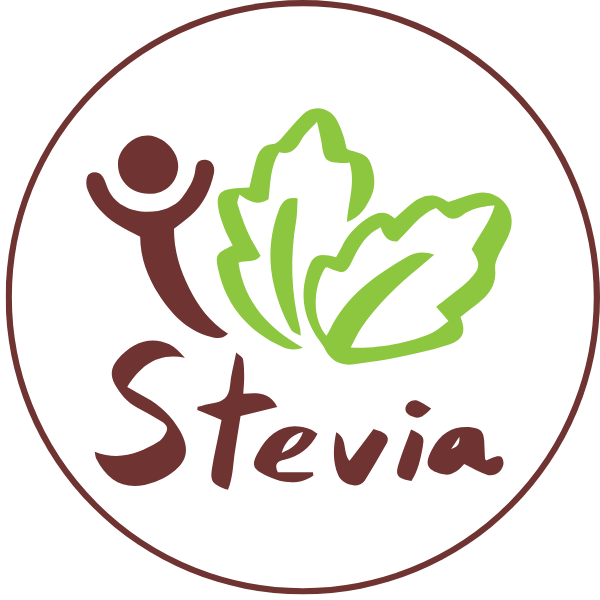

Winter special sugar free halwa combo @499



Aarti Laxman (Founder)
Artinci is founded by Aarti Laxman, a certified Metabolic coach in the Low-Carb Nutrition & Metabolic Health domain from dLife.in, India’s only legally tenable course in this subject—recognized by the NSDC (under the Ministry of Skill Development & Entrepreneurship, Govt. of India). It’s also internationally accredited by the CPD Standards Office UK, with a global record of 144 CPD hours—the highest for any course of its kind. The accreditation is both nationally valid and globally recognised in over 50+ countries..
Festive Gifting in Artinci
Let customers speak for us
All about Sugar and sugar-free

Imagine your body as a finely tuned machine, with insulin acting as the key that unlocks cells to let glucose in. When this system malfunctions - a condition known as insulin resistance - your cells stop responding effectively to insulin's signals. This creates a troubling cycle: blood sugar levels rise, forcing your pancreas to produce more insulin in a desperate attempt to maintain balance. Following an insulin resistance diet can help manage and improve this condition by focusing on foods that support better insulin sensitivity and overall health.Many people believe cutting sugar alone is the magic solution to reverse insulin resistance. While reducing sugar intake plays a vital role, the reality is more complex. Your body's relationship with insulin involves multiple factors, from the foods you eat to your daily habits and lifestyle choices.Left unchecked, insulin resistance can lead to serious health complications: Type 2 diabetes Heart disease Fatty liver disease Increased risk of certain cancers Potential links to Alzheimer's disease The good news? You can take practical steps to improve your insulin sensitivity and protect your long-term health. Let's explore how a comprehensive approach - beyond just eliminating sugar - can help you regain control of your metabolic health.While it's important to reduce sugar intake, it's equally crucial to understand that not all sugar-free products are created equal. For instance, some sugar-free products may be healthier than their regular counterparts.In this regard, incorporating healthier alternatives like keto-friendly almond cookies, which are both diabetic-friendly and delicious, could be beneficial. These cookies are made with 100% almond flour and sweetened with low GI stevia, making them an ideal choice for those struggling with insulin resistance.The Complex Relationship Between Sugar and Insulin ResistanceSugar's role in insulin resistance isn't as straightforward as many believe. While excessive sugar intake can disrupt your body's insulin response, it's just one piece of a larger metabolic puzzle.Let's break down the key dietary factors that affect insulin sensitivity:1. Sugar and Refined Carbohydrates White bread, pastries, and sugary drinks spike blood glucose rapidly. These quick spikes force your pancreas to release more insulin. Regular exposure to high insulin levels can lead to decreased cellular sensitivity. 2. Hidden Dietary Culprits Processed Foods: Often contain hidden sugars and harmful additives. Trans Fats: Interfere with cell membrane function and insulin signaling. Artificial Sweeteners: While some may seem like a viable alternative, others, such as erythritol, have their own set of benefits and risks. 3. The Fat Factor Saturated fats from processed meats can promote inflammation. Excessive omega-6 fatty acids disrupt cellular insulin reception. Poor quality fats contribute to weight gain and metabolic dysfunction. Your body's insulin response depends on multiple dietary components working together. A blood test can reveal insulin resistance, but your daily food choices play a crucial role in prevention and management. Moreover, exploring alternative sweeteners could be beneficial. For instance, jaggery is often debated as a healthier alternative to refined sugar. Is jaggery a good alternative sweetener for diabetics? This is an important consideration for those looking to manage their sugar intake while still enjoying sweet flavors.In addition to these dietary factors, recent studies suggest that certain lifestyle changes can also significantly improve insulin sensitivity. For example, engaging in regular physical activity has been shown to enhance the body's ability to respond to insulin effectively. Moreover, maintaining a healthy weight is crucial as obesity is a major risk factor for developing insulin resistance. Research indicates that even modest weight loss can lead to improvements in insulin sensitivity. Therefore, adopting a holistic approach that includes balanced nutrition, regular exercise, and weight management could yield significant benefits for those struggling with insulin resistance.Benefits of a Comprehensive Approach to Reversing Insulin ResistanceCutting sugar intake alone isn't enough to effectively reverse insulin resistance. A comprehensive strategy creates powerful synergistic effects that accelerate your progress toward better metabolic health.Here's what happens when you combine multiple approaches: Enhanced Fat Burning: Reducing sugar while exercising regularly activates your body's natural fat-burning mechanisms, improving insulin sensitivity in muscle tissue. To help with sugar reduction, consider exploring sugar-free products which can assist in managing your sugar intake. Balanced Blood Sugar: A whole foods diet rich in fiber works with regular movement to stabilize glucose levels throughout the day. Reduced Inflammation: The combination of proper nutrition and stress management techniques decreases inflammatory markers that contribute to insulin resistance. Improved Cell Function: Quality sleep paired with a nutrient-dense insulin resistance diet helps repair and regenerate insulin-sensitive cells Research shows that people who adopt multiple lifestyle changes experience a 50-70% greater improvement in insulin sensitivity compared to those who focus on dietary changes alone.The key lies in creating a sustainable lifestyle that supports metabolic health through multiple channels. When you combine proper nutrition with regular physical activity, stress management, and adequate rest, each element amplifies the benefits of the others, creating lasting positive changes in your body's insulin response.1. Embrace a Whole Foods-Based Diet for Better Insulin SensitivityA whole foods-based diet creates the perfect foundation for reversing insulin resistance. Here's what to include in your daily meals:Non-starchy vegetables: Leafy greens, broccoli, and bell peppers provide essential nutrients while maintaining stable blood sugar levels and are rich in antioxidants that protect insulin-producing cells.Fiber-rich fruits: Berries, apples, and citrus fruits slow down glucose absorption, provide natural sweetness without blood sugar spikes, and incorporating more fiber-rich foods can significantly improve diabetes control during fasting periods like Ramadan.Whole grains and lean proteins: Quinoa, brown rice, and oats release energy gradually while fish, chicken, and legumes support muscle health and glucose metabolism.Healthy fats: Nuts, seeds, avocados, and even olives improve insulin sensitivity and are essential for hormone production and nutrient absorption.These foods work together to: Stabilize blood sugar levels Reduce inflammation Support gut health Enhance cellular insulin response Pro tip: Replace processed snacks with whole food alternatives like apple slices with almond butter or carrot sticks with hummus for better blood sugar control. You could also try our sugar-free almond flour cake as a healthier dessert option.2. Make Regular Exercise a Top Priority to Fight Insulin ResistanceExercise is crucial in managing insulin resistance for various reasons. When you engage in physical activity, your muscles become better at using glucose both during and after the workout, leading to a natural decrease in blood sugar levels.Aerobic Exercise: Brisk walking for 30 minutes Swimming or cycling sessions Dancing or aerobic classes Improves heart health while enhancing insulin sensitivityStrength Training: Resistance exercises with weights or bands Bodyweight exercises like push-ups and squats Builds lean muscle mass that acts as a glucose reservoir and enhances metabolic rate for better blood sugar controlThe real magic happens when you combine both aerobic and strength training exercises. A well-rounded workout routine that includes 150 minutes of moderate aerobic activity and 2-3 strength training sessions each week creates the best conditions for insulin sensitivity. This means your muscles become more responsive to insulin, requiring less of this hormone to process the same amount of glucose.Remember to start slowly and choose activities you enjoy - being consistent is more important than pushing yourself too hard when it comes to improving insulin sensitivity through exercise. 3. Make Sustainable Lifestyle Changes Beyond Insulin Resistance DietYour path to reversing insulin resistance extends beyond the kitchen and gym. Research shows that stress triggers the release of cortisol, a hormone that can raise blood sugar levels and promote insulin resistance. Simple stress-reduction techniques can make a significant difference: Practice daily meditation or deep breathing exercises Try gentle yoga Set boundaries to protect your mental well-being Consider journaling or mindfulness activities Quality sleep plays a crucial role in blood sugar regulation. Adults who consistently get less than 7 hours of sleep show decreased insulin sensitivity. Create a sleep-friendly environment by: Maintaining a consistent bedtime routine Keeping your bedroom cool and dark Limiting screen time before bed Avoiding caffeine in the late afternoon Proper hydration supports your body's insulin response. Replace sugary drinks with water and herbal teas. A good rule of thumb: drink enough water that your urine maintains a light, straw-colored appearance throughout the day.These lifestyle modifications work together with an insulin resistance diet and exercise to create lasting improvements in insulin sensitivity. Small, consistent changes in these areas can lead to significant health benefits over time.4. Seek Professional Guidance if Needed on Your Journey Towards Better Insulin SensitivityWhile cutting sugar and lifestyle changes form the foundation of reversing insulin resistance, some individuals might benefit from professional medical guidance. A healthcare provider can: Conduct comprehensive blood tests to assess insulin and glucose levels Screen for underlying health conditions affecting insulin sensitivity Recommend appropriate supplements or medications when necessary Create personalized treatment plans based on individual health status Medical interventions might include: Metformin: A prescription medication that helps improve insulin sensitivity Berberine supplements: Natural compounds that support glucose metabolism Chromium and magnesium: Minerals that may enhance insulin function Alpha-lipoic acid: An antioxidant showing promise in improving insulin sensitivity Remember: These interventions work best when combined with proper insulin resistance diet and exercise. A qualified healthcare provider can help determine if you need additional support beyond lifestyle modifications and monitor your progress effectively.ConclusionReversing insulin resistance doesn't have to be complicated. By following these 5 evidence-based steps, you can take control of your metabolic health: Embrace whole, nutrient-dense foods Make exercise a daily habit Create sustainable lifestyle changes Reduce sugar intake strategically Work with healthcare professionals when needed Your journey to better insulin sensitivity is unique, and you deserve personalized support along the way. At Artinci, we specialize in creating products that help you embrace your whole health, nutrient-dense foods, while also satisfying your cravings.We understand that reducing sugar intake can be challenging. That's why our products are rooted in science and carefully designed to ensure you get the best of taste using the best of ingredients. For those looking for guilt-free indulgence, our sugar free sweets collection offers a delicious and healthy option that perfectly fits a keto or diabetic-friendly diet.Ready to transform your relationship with food and improve your metabolic health? Let's work together to create lasting change that goes beyond simply cutting sugar. Take the first step today - your future self will thank you.Disclaimer: The information provided in this article is for educational purposes only and should not replace professional medical advice. Always consult with a healthcare professional before making any changes to your diet or exercise routine.FAQs 1.Does cutting sugar reverse insulin resistance?Cutting sugar intake can help improve insulin sensitivity, but it is not the sole factor in reversing insulin resistance. A comprehensive approach that includes diet, exercise, and lifestyle changes is essential for effectively managing insulin resistance.2.What is insulin resistance and why is it important to address?Insulin resistance occurs when the body's cells become less responsive to insulin, leading to elevated blood glucose levels. Addressing insulin resistance is crucial as it can impact overall health and increase the risk of developing type 2 diabetes and other metabolic disorders.3.How does sugar intake affect insulin sensitivity?Excessive sugar consumption can contribute to impaired insulin sensitivity by causing spikes in blood glucose and increasing fat accumulation. However, other dietary factors like refined carbohydrates and unhealthy fats also play significant roles in affecting insulin resistance.4.What dietary changes support reversing insulin resistance?Adopting a whole foods-based diet rich in non-starchy vegetables, fiber-rich fruits, whole grains, lean proteins, nuts, and seeds helps manage blood glucose levels and promotes better insulin sensitivity.5.How does exercise help improve insulin resistance?Both aerobic and strength training exercises enhance muscle glucose uptake, which supports overall metabolic health and improves insulin sensitivity. Regular physical activity is a key strategy in managing and reversing insulin resistance.

How to Stay Hydrated with No Sugar Drinks in Just 5 Easy Steps
Staying hydrated is essential for managing diabetes, but it can be challenging to find the right drinks. Your body needs enough fluids to keep blood sugar levels stable, support kidney function, and prevent dehydration - a condition that can be especially dangerous for people with diabetes.Many popular beverages contain hidden sugars that can cause blood glucose levels to spike. The good news? There are plenty of delicious, sugar-free beverages out there to keep you refreshed and healthy.Key benefits of choosing no-sugar drinks: Helps maintain steady blood sugar levels Supports weight management goals Reduces risk of diabetes complications Provides essential hydration without unwanted calories The secret is knowing which drinks are best for your body. From naturally flavored water to unsweetened teas, there are many options that are both satisfying and good for you. In this article, we'll share five simple steps you can take to improve your hydration habits while keeping your blood sugar in check.Ready to discover your new favorite sugar-free beverages? These practical strategies will help you stay refreshed without compromising your health goals. 1. Choose Water as Your Primary BeverageWater is the best choice for people with diabetes when it comes to staying hydrated. It's calorie-free, sugar-free, and helps keep your blood sugar levels steady while also supporting your body's important functions.Why Water is Great for Managing Blood Sugar: It helps get rid of extra sugar through urine It stops dehydration from causing blood sugar spikes It reduces false hunger signals that can lead to overeating Your body takes in pure water directly into your bloodstream without having to process it, making it the best way to hydrate. This quick absorption helps maintain healthy blood volume and supports kidney function - both of which are crucial for managing diabetes.Creative Ways to Make Water More Exciting: Add fresh cucumber slices and mint leaves Infuse with citrus fruits like lemon, lime, or orange Drop in a few berries for natural sweetness Try herbs like rosemary or basil for unique flavors Pro tip: Keep a reusable water bottle filled and visible throughout your day. Studies show people drink up to 25% more water when it's readily accessible.In addition to staying hydrated, incorporating fiber-rich foods into your diet can significantly aid in managing diabetes. These foods not only help regulate blood sugar levels but also provide a feeling of fullness, reducing the chances of overeating.Lastly, don't forget to explore some delicious options from our best-selling range that include cakes, cookies, chocolates and more which can be enjoyed in moderation while keeping your health in check.2. Incorporate Unsweetened Teas and Coffees into Your RoutineTea and coffee offer excellent alternatives to sugary drinks while providing potential health benefits for blood sugar management. Green tea contains powerful antioxidants called catechins that may improve insulin sensitivity and reduce blood sugar levels.Diabetic-Friendly Tea Options: Green tea - rich in metabolism-boosting compounds Chamomile tea - supports better sleep and stress reduction Ginger tea - aids digestion and reduces inflammation Cinnamon tea - may help stabilize blood sugar levels Peppermint tea - refreshing and caffeine-free When preparing your hot beverages, skip the sugar and try these alternatives: Add a slice of lemon or orange Use a sprinkle of cinnamon or nutmeg Try stevia or monk fruit sweetener if needed Experiment with vanilla extract for natural sweetness Black coffee contains zero carbohydrates and may improve glucose metabolism. Research suggests regular coffee consumption could reduce type 2 diabetes risk by up to 50%. Remember to drink your coffee black or with unsweetened plant-based milk to maintain its blood sugar-friendly benefits.3. Opt for Low-Carb Vegetable Juices and Explore Zero Sugar Juice OptionsVegetable juices offer a refreshing alternative to fruit-based beverages while keeping blood sugar levels stable. Fresh cucumber, celery, and spinach juices contain minimal carbohydrates and pack essential nutrients like potassium and vitamin C. These non-starchy vegetables are ideal for juicing.Creating Your Own Low-Carb Juice Blends: Mix leafy greens with cucumber for a hydrating base Add small amounts of lemon or lime for natural flavor Include herbs like mint or basil for complexity Blend in a single carrot or beet for sweetness without sugar spikes For those looking to explore healthier sweetener alternatives, it's worth considering options like monk fruit, although it's essential to note that it still contains sugar.Smart Dilution Techniques: Mix vegetable juice with sparkling water (1:1 ratio) Add ice cubes to reduce concentration Combine with unsweetened coconut water When buying commercial vegetable juices, check labels for hidden sugars under names like corn syrup, fruit juice concentrate, or dextrose. Choose options with less than 5g of carbohydrates per serving for optimal blood sugar management.Also, consider exploring sugar-free products as they have become more popular recently due to growing health concerns about sugar. However, it's crucial to remember that not all sugar-free products are necessarily healthier than their regular counterparts.In addition to vegetable juices, incorporating low-carb foods into your diet can also be beneficial. This approach not only aids in weight management but also contributes to better blood sugar control.Lastly, if you're craving something sweet but want to avoid sugar, you might want to try some delicious sugar-free Motichoor Ladoo, a traditional Indian sweet made with pure ghee and no added sugar.4. Select Sugar-Free Energy Drinks and Soft Drinks with Caution, If NeededSugar-free energy drinks and soft drinks might seem like perfect alternatives, but they require careful consideration. These beverages often contain artificial sweeteners and high caffeine levels that can impact your health:Sugar-Free Energy Drinks - Key Concerns: Excessive caffeine content can raise blood pressure Artificial sweeteners may alter gut bacteria Some brands contain high sodium levels Risk of developing caffeine dependency Diet Sodas - What Research Shows: Links to increased waist circumference Potential changes in insulin sensitivity Risk of bone density reduction Dental enamel erosion from acidic content For occasional consumption, opt for brands with natural sweeteners like stevia, which has been shown to have fewer adverse effects compared to other artificial sweeteners. Read labels carefully - some sugar-free beverages contain hidden carbs or concerning additives. Limit intake to one serving per day, and consider timing your consumption away from meals to minimize potential metabolic effects.5. Use Milk Alternatives and Green Smoothies Smartly in Your DietPlant-based milk alternatives offer diabetic-friendly hydration options. Unsweetened almond milk contains just 30 calories per cup with zero sugar, making it an excellent choice for blood sugar management. You can even enjoy delicious almond flour keto cookies as a snack which are made with 100% almond flour and sweetened with low GI stevia, making them diabetic-friendly. Soy milk provides 7 grams of protein per serving, helping maintain stable glucose levels while keeping you satisfied.Green smoothies create nutrient-rich hydration when prepared thoughtfully: Blend leafy greens like spinach or kale with cucumber for a low-sugar base Add protein powder or chia seeds to slow sugar absorption Include healthy fats from avocado to enhance nutrient absorption Mix in berries sparingly for natural sweetness without sugar spikes Pro tip: Check labels carefully - some milk alternatives contain hidden sugars or carrageenan, which may cause inflammation. Opt for brands specifically labeled "unsweetened" to ensure zero added sugars. Additional Hydration Tips for Diabetics: Beyond No Sugar DrinksEnhance your hydration routine with these creative sugar-free options:Natural Flavor Infusions Fresh mint leaves + cucumber slices Rosemary sprigs + grapefruit wedges Basil leaves + strawberry pieces Cinnamon sticks + apple slices Sports Drink Guidelines For light exercise (<1 hour): Water is sufficient For intense workouts (>1 hour): Sugar-free electrolyte drinks Check with your healthcare provider for personalized recommendations based on: Exercise intensity Blood sugar patterns Individual hydration needs Pro tip: Create ice cubes with herbs or fruit pieces to add subtle flavor as they melt. This method provides a refreshing taste without impacting blood sugar levels.Cautions on Certain Beverages and Alcohol Consumption for DiabeticsAlcohol poses specific risks for people with diabetes. The American Diabetes Association recommends limiting alcohol to: Women: 1 drink per day Men: 2 drinks per day Key alcohol-related risks: Blocks liver's glucose production Masks hypoglycemia symptoms Interferes with diabetes medications Increases blood pressure Beverages to approach with caution: Mixed cocktails with sugary mixers Sweet wines and liqueurs Craft beers high in carbohydrates Frozen alcoholic drinks Your safest alcohol options include: Dry wines Light beers Clear spirits with sugar-free mixers Remember to check blood sugar levels before, during, and after drinking alcohol. Never drink on an empty stomach - pair alcoholic beverages with food to help stabilize blood sugar levels.Disclaimer:Always drink responsibly and be mindful of how alcohol can affect your blood sugar levels, especially when taking diabetes medications. It's crucial to monitor your blood sugar regularly and avoid drinking on an empty stomach to prevent any potential complications.In this regard, opting for sugar-free alternatives like our Keto-friendly Almond Cake or sugar-free coconut cookies can be beneficial. These diabetic-friendly options are not only delicious but also help in maintaining stable blood sugar levels while enjoying a treat.ConclusionStaying hydrated with sugar-free beverages doesn't mean sacrificing taste or variety. Your journey to better hydration starts with making informed choices that support your blood sugar management goals.Artinci offers a range of diabetic-friendly beverage options tailored to your needs. Our selection includes carefully curated products that align with the hydration strategies discussed in this guide. Ready to take the next step? Connect with healthcare professionals through Artinci's platform for personalized hydration advice. Our experts can help create a beverage plan that fits your lifestyle and dietary requirements.Remember: The right hydration choices empower you to maintain optimal blood sugar levels while enjoying refreshing drinks throughout your day.And if you're looking for some sweet treats, we also have a range of sugar-free diabetic-friendly sweets that are crafted to keep in mind your overall health.FAQs1.What are the best sugar-free beverages for diabetics to stay hydrated?The best sugar-free beverages for diabetics include water, unsweetened teas and coffees, low-carb vegetable juices, zero sugar juice options, and certain milk alternatives like unsweetened almond or soy milk. These drinks help maintain hydration without impacting blood sugar levels.2.Why is water considered the best sugar-free beverage for diabetics?Water naturally hydrates the body without affecting blood sugar levels or adding calories. It supports blood sugar control and weight management, making it the ideal primary beverage for diabetics. Enhancing water with natural flavors like lemon or cucumber can make it more enjoyable.3.Can diabetics drink unsweetened teas and coffees safely?Yes, unsweetened teas and coffees are excellent sugar-free options for diabetics. Herbal teas and green tea offer health benefits related to blood sugar regulation. Sweeteners should be used sparingly if needed to keep drinks sugar-free.4.Are vegetable juices better than fruit juices for diabetics?Yes, low-carb vegetable juices are preferable because they have lower carbohydrate content compared to fruit juices, reducing the impact on blood sugar. Diluting juices can further decrease their sugar effect. Zero sugar juice brands or homemade recipes are good alternatives.5.Should diabetics consume sugar-free energy drinks and soft drinks?Sugar-free energy drinks and diet sodas should be consumed with caution. Although they contain no sugar, some may pose metabolic health risks. It's important to weigh the benefits and drawbacks before including them in a diabetic diet.

How Does a Sugar-Free Diet Help Manage Type 2 Diabetes?
Type 2 diabetes affects millions worldwide, making it one of the most significant health challenges of our time. This metabolic disorder disrupts how your body processes glucose, leading to consistently high blood sugar levels that can damage vital organs. Diet plays a crucial role in managing Type 2 diabetes. Research shows that what you eat directly impacts your blood glucose levels, making dietary choices essential for disease management.A sugar-free type 2 diabetes diet has emerged as a powerful tool for individuals with Type 2 diabetes. By eliminating or significantly reducing sugar intake, many people experience better blood sugar control and improved health outcomes. This approach requires careful planning and understanding - it's not just about cutting out desserts, but making informed choices about all food sources that affect blood glucose levels.However, adopting a sugar-free diet doesn't mean you have to give up on enjoying delicious treats. For instance, Artinci offers a range of guilt-free indulgences like our Almond Cakes, which are gluten-free, sugar-free, and perfect for those following a keto or diabetic-friendly diet.Managing Type 2 diabetes involves more than just dietary changes; it also includes making conscious decisions about the impact of those choices on our planet. With resources like Artinci's best sellers, individuals can enjoy delicious food while adhering to their health goals and supporting a sustainable future. Understanding Type 2 DiabetesType 2 diabetes occurs when your body becomes resistant to insulin, a hormone that regulates blood sugar levels. Unlike Type 1 diabetes, where the body doesn't produce insulin, Type 2 diabetes affects how your body processes glucose.Your pancreas initially tries to compensate by producing extra insulin, but it can't keep up long-term. This leads to elevated blood sugar levels, causing damage to: Blood vessels Nerves Major organs Vision Heart health Several factors increase your risk of developing Type 2 diabetes: Genetic predisposition: Family history plays a significant role Age: Risk increases after 45 Weight: Excess body fat, particularly around the abdomen Sedentary lifestyle: Lack of regular physical activity Poor diet: High consumption of processed foods and sugary beverages Ethnicity: Higher risk in certain populations Medical conditions: Including PCOS and high blood pressure The Role of Diet in Managing Type 2 DiabetesA well-balanced diet is essential for managing blood sugar levels in individuals with Type 2 diabetes. The foods you eat have a direct impact on your glucose levels, making it crucial to make informed dietary choices.Understanding Carbohydrates and Their EffectsCarbohydrates play a significant role in blood sugar management. However, not all carbohydrates affect your body in the same way. Here's a breakdown of how different types of carbohydrates can influence your blood sugar levels:1. Simple Carbohydrates These carbohydrates are digested quickly by the body. As a result, they can cause rapid spikes in blood sugar levels. Common sources of simple carbohydrates include white bread, sugary drinks, and pastries. 2. Complex Carbohydrates Unlike simple carbohydrates, complex carbohydrates break down slowly. This means they provide a steady release of energy over time. Whole grains, legumes, and vegetables are excellent sources of complex carbohydrates. The Importance of the Glycemic IndexIn addition to understanding different types of carbohydrates, it's also important to consider the glycemic index (GI) of foods. The GI measures how quickly specific foods raise blood sugar levels after consumption.High-GI foods such as white rice and potatoes can lead to significant spikes in glucose levels. On the other hand, low-GI options like quinoa and sweet potatoes offer better control over blood sugar fluctuations.Exploring Sweetener AlternativesWhen it comes to sweetening foods, many people with diabetes often seek alternatives to traditional sugar. While jaggery may seem like a healthier option, it's essential to understand its effects on blood sugar before making any dietary changes.Benefits of Adopting a Sugar-Free Diet for Type 2 Diabetes ManagementA sugar-free diet creates powerful changes in blood sugar regulation. Research shows reduced sugar intake leads to improved insulin sensitivity, helping cells respond better to available insulin. This metabolic shift allows for better glucose absorption and utilization throughout the body.The benefits extend beyond blood sugar control: Enhanced Weight Management: A low-carb, sugar-free approach naturally reduces calorie intake, supporting sustainable weight loss. Decreased Inflammation: Lower blood sugar levels help reduce systemic inflammation linked to diabetes complications. Improved Energy Levels: Stable blood sugar prevents energy crashes common with high-sugar diets. Reduced Medication Needs: Some individuals require less diabetes medication when following a consistent sugar-free eating plan. Studies indicate that maintaining a sugar-free diet can slow disease progression by preserving beta cell function - the cells responsible for insulin production. This protective effect, combined with better blood sugar control, creates a foundation for long-term diabetes management.Moreover, adopting a sugar-free diet doesn't mean sacrificing taste or enjoyment in food. With the rise of sugar-free products, individuals can still indulge in their favorite treats while managing their sugar intake. For instance, one can enjoy an almond cake that's keto and gluten-free, perfect for those on a weight loss or diabetic-friendly diet.In addition, incorporating more fiber into meals can also be beneficial. Fiber supports diabetes control by aiding in digestion and providing a feeling of fullness, which can help with weight management. Furthermore, it's worth noting that adopting such dietary changes can also lead to overall health improvements beyond just managing diabetes symptoms.Creating a Sugar-Free Diet Plan for Type 2 DiabetesA successful sugar-free diet plan focuses on nutrient-dense foods that keep blood sugar levels stable while providing essential vitamins and minerals. The key lies in strategic meal planning and smart food choices.Building Your Daily Meal Structure: Start with protein-rich breakfasts Include small, frequent meals throughout the day Plan snacks to prevent blood sugar dips Balance each meal with proper portions Smart Food Combinations: Pair proteins with high-fiber vegetables Add healthy fats to slow down carbohydrate absorption Include complex carbohydrates in controlled portions Choose foods with a low glycemic index Creating a sustainable meal plan requires attention to portion sizes and timing. A typical day might include Greek yogurt with berries for breakfast, a leafy green salad with grilled chicken for lunch, and baked fish with roasted vegetables for dinner. Healthy sugar-free snacks between meals help maintain steady blood sugar levels.Essential Kitchen Staples: Fresh vegetables and leafy greens Lean proteins (chicken, fish, tofu) Nuts and seeds Healthy oils (olive, avocado) Low-glycemic fruits Whole grains in moderation Meal prep plays a vital role in maintaining a sugar-free lifestyle. Preparing meals in advance helps avoid impulsive food choices and ensures nutritious options are always available.For those moments when you're craving something sweet, consider incorporating sugar-free options like Kaju Katli or gluten-free almond cookies. These treats are not only delicious but also fit perfectly within a diabetic-friendly diet.Potential Risks and Considerations When Following a Sugar-Free Diet for Diabetes ManagementA sugar-free diet requires careful attention to hidden ingredients that can impact blood glucose levels. Many products labeled "sugar-free" contain sugar alcohols like xylitol or sorbitol, which can still affect blood sugar and cause digestive issues in some people.Common Hidden Sources of Sugar: Sugar-free desserts Diet sodas "No added sugar" products Sugar-free candy Processed snack foods Some sugar-free products rely on artificial sweeteners, which research suggests might influence: Insulin sensitivity Gut microbiome health Food cravings Reading nutrition labels becomes essential - watch for terms like: Dextrose Maltodextrin Modified corn starch Corn syrup solids These ingredients can impact blood glucose levels despite "sugar-free" claims. Choosing whole, unprocessed foods creates a safer approach to managing Type 2 diabetes through diet.However, not all sugar substitutes are created equal. For instance, erythritol is gaining popularity as a sugar substitute due to its unique properties. It's important to understand its benefits and risks for informed choices.It's also crucial to question the common perception that sugar-free products are inherently healthier. Lastly, understanding the science behind zero-sugar sweeteners can further aid in making healthier choices. Monitoring Blood Glucose Levels During Dietary ChangesRegular blood glucose monitoring becomes crucial when transitioning to a sugar-free diet. A blood glucose diary helps track how different foods affect your levels throughout the day.Key monitoring times include: First thing in the morning Before meals 2 hours after meals Before and after exercise Physical activity plays a vital role alongside dietary changes. A combination of aerobic exercises and resistance training can: Improve insulin sensitivity Help maintain healthy blood sugar levels Support weight management goals Reduce cardiovascular risks Recommended weekly activity targets: 150 minutes of moderate-intensity aerobic activity 2-3 resistance training sessions Daily walking or light movement Remember to check blood glucose before, during, and after exercise sessions - especially when starting a new routine. Adjust medication timing and dosage based on your healthcare provider's guidance as your diet and activity levels change.Seeking Personalized Guidance from Healthcare ProfessionalsMaking dietary changes to manage Type 2 diabetes requires expert guidance. A registered dietitian or diabetes educator can: Create a personalized meal plan based on your specific health needs Help identify hidden sugars in foods Adjust portion sizes for optimal blood sugar control Monitor nutritional deficiencies Recommend appropriate sugar-free alternatives Your healthcare team will consider factors like: Current medication regimen Activity level Medical history Personal food preferences Lifestyle constraints Regular check-ups allow professionals to track your progress and make necessary adjustments to your sugar-free diet plan. This collaborative approach ensures you receive proper nutrition while effectively managing your diabetes.Disclaimer: The information in this article is for educational purposes only and should not be used as a substitute for professional medical advice. Always consult with your healthcare provider or diabetes specialist before making any significant changes to your diet or exercise routine. FAQs1.What is Type 2 diabetes and how prevalent is it?Type 2 diabetes is a chronic condition characterized by insulin resistance and elevated blood glucose levels. It differs from other types of diabetes in its development and management. This condition is highly prevalent worldwide, affecting millions, and requires effective management to prevent complications.2.How does a sugar-free diet help manage Type 2 diabetes?A sugar-free diet helps manage Type 2 diabetes by reducing the intake of refined sugars and high-glycemic index foods, which can cause spikes in blood glucose levels. This dietary approach improves insulin sensitivity, aids in blood sugar control, supports weight management, and may slow disease progression when followed safely.3.What foods should be included or avoided in a sugar-free diet for Type 2 diabetes?Recommended foods include nutrient-dense options low in sugar and carbohydrates such as whole grains, vegetables, healthy fats like avocados and nuts, and lean proteins. Foods to avoid are those high in refined sugars, sugary beverages, processed snacks, and products with hidden sugars or unhealthy additives to maintain stable blood glucose levels.4.Are there any potential risks or considerations when following a sugar-free diet for diabetes management?Yes, potential risks include insufficient nutrient intake if the diet excludes essential food groups. Some sugar-free labeled products may contain hidden sugars or unhealthy additives that could impact blood glucose control. It's important to incorporate whole, unprocessed foods and monitor overall nutrition while following this diet.5.How important is monitoring blood glucose levels during dietary changes for Type 2 diabetes?Monitoring blood glucose levels is crucial when making dietary changes to understand how different foods affect your blood sugar. Regular tracking helps adjust meal plans effectively to maintain optimal glucose control and prevent hypoglycemia or hyperglycemia episodes during the transition to a sugar-free diet.

Are Sugar-Free Desserts Keto-Friendly? Discover the Truth
Sugar-free desserts have become a beacon of hope for keto dieters seeking to satisfy their sweet tooth without derailing their progress.The sugar-free keto diet is a low-carb, high-fat eating pattern that transforms your body into a fat-burning machine. By drastically reducing carbohydrate intake to about 20-50 grams per day, your body enters ketosis - a metabolic state where fat becomes the primary fuel source.The Appeal of Sugar-Free DessertsSugar-free desserts appear to be the perfect solution for keto followers. These treats replace traditional sugars with alternative sweeteners like erythritol that don't spike blood glucose levels.The Reality CheckBut here's the catch - not all sugar-free desserts align with keto principles.The key lies in understanding: The specific sweeteners used The base ingredients in the recipe The total net carb count per serving A truly keto-friendly sugar-free dessert combines approved sweeteners like stevia or monk fruit with low-carb ingredients such as almond flour, coconut flour, or sugar-free chocolate. This careful balance allows you to enjoy sweet treats while maintaining ketosis. For those times when you're searching for keto-friendly desserts, there are plenty of options available that fit within your dietary restrictions on a sugar-free keto diet.Understanding the Ketogenic Diet and Its Snack RequirementsThe ketogenic diet is a high-fat, moderate-protein, and extremely low-carbohydrate eating plan. This specific macronutrient distribution triggers a metabolic state called ketosis, where your body shifts from using glucose as its primary fuel source to burning fat for energy. Incorporating a sugar-free keto diet ensures that you avoid sugars that can disrupt ketosis, thereby supporting the body's ability to burn fat efficiently.A standard keto diet typically follows these macronutrient ratios: 70-80% of calories from fat 20-25% of calories from protein 5-10% of calories from carbohydrates This translates to limiting daily carbohydrate intake to 20-50 grams, making snack choices particularly crucial for maintaining ketosis.The Importance of Smart Snacking in KetoSmart snacking plays a vital role in the keto lifestyle. Low-carb snacks help: Maintain steady blood sugar levels Prevent hunger between meals Keep you in ketosis Support energy levels throughout the day Popular Keto-Friendly SnacksPopular keto-friendly snack options include: Hard-boiled eggs Cheese crisps Nuts and seeds Celery with cream cheese Sugar-free dark chocolate The Role of Preparation in Successful Keto SnackingThe key to successful keto snacking lies in preparation. Having ready-to-eat, keto-compliant options prevents impulsive choices that could derail ketosis. This makes sugar-free desserts an attractive option for those following a ketogenic diet, provided they're made with appropriate ingredients.Sugar-Free Desserts: A Closer Look at Keto-Friendly IngredientsRegular sugar disrupts ketosis by spiking blood glucose and insulin levels. Just one teaspoon of sugar contains 4 grams of carbs - a significant portion of your daily keto carb limit. The good news? You can satisfy your sweet cravings with keto-friendly alternatives. Popular Low-Carb Sweeteners for Keto Desserts: Natural Options Stevia (0g net carbs) Monk Fruit (0g net carbs) Allulose (0.4g net carbs per teaspoon) Sugar Alcohols Erythritol (0g net carbs) Xylitol (0g net carbs) Swerve (0g net carbs) These sweeteners maintain ketosis while providing the sweetness you crave. Many come in granulated forms that measure cup-for-cup like sugar, making them perfect for baking keto treats. However, it's crucial to understand the impact of these sweeteners on your health. For instance, artificial sweeteners can have varying effects on insulin levels, which is an important factor for those managing diabetes. Incorporating these into a sugar-free keto diet requires careful consideration to ensure they support your overall health goals.Essential Keto Baking Ingredients: Almond flour Coconut flour Sugar-free chocolate Natural nut butters Heavy cream Cream cheese Eggs When selecting ingredients, watch for hidden carbs in products labeled "sugar-free." Some manufacturers replace sugar with maltodextrin or other high-glycemic alternatives that can kick you out of ketosis. Reading ingredient labels helps ensure your desserts stay truly keto-friendly.You might wonder, can you eat sugar-free sweets on keto? The answer is a resounding yes! With the right ingredients and sweeteners, you can enjoy delicious desserts without jeopardizing your diet.Speaking of ingredients, consider trying sugar-free coconut cookies as a delightful treat. These cookies are not only keto-friendly but also sweetened with a natural, low-glycemic stevia blend, making them diabetic-friendly and made with real coconut!Be Cautious: Hidden Carbs in 'Sugar-Free' Products Can Sabotage Your Keto Journey!The "sugar-free" label can be misleading when following a ketogenic lifestyle. Many commercially available sugar-free desserts contain ingredients that can spike blood sugar and knock you out of ketosis.Common Hidden Carb Sources: Modified food starch Maltodextrin Dextrose Corn syrup solids Wheat flour Rice flour Tapioca starch These ingredients often appear in sugar-free products to improve texture and taste, yet they can significantly impact your daily carb intake. A single serving of "sugar-free" cookies might contain 15-20g net carbs - nearly your entire daily allowance on keto.Reading Labels Like a Pro: To navigate these tricky labels, it's essential to understand what to look for. Here are some tips: Check the total carbohydrates, not just sugar content Look for fiber content to calculate net carbs Scan the ingredient list for hidden starches Pay attention to serving sizes Verify the type of sweeteners used Many sugar-free products marketed as "diabetic-friendly" aren't necessarily sugar-free keto diet compatible. Some manufacturers replace sugar with other high-carb alternatives or use sugar alcohols that can affect blood glucose levels.Making your own keto desserts gives you complete control over ingredients. This way, you can ensure every component aligns with your ketogenic goals while satisfying your sweet cravings.ConclusionSugar-free desserts can be compatible with a ketogenic lifestyle when you make smart choices. The key lies in selecting treats made with keto-approved sweeteners and low-carb ingredients.Your sugar-free keto diet journey deserves thoughtful consideration of every ingredient that goes into your body. With knowledge about proper sweeteners and careful label reading, you can enjoy delicious sugar-free desserts while maintaining ketosis.Remember: Choose desserts with natural keto sweeteners like stevia or monk fruit Read ingredient lists thoroughly Track your daily carb intake Prepare homemade treats when possible The world of keto-friendly desserts offers endless possibilities - embrace them wisely and satisfy your sweet tooth while staying true to your health goals. For instance, you might want to try our sugar-free chocolate brownie, a diabetic-friendly delight that aligns perfectly with both keto and diabetic dietary requirements.Additionally, it's essential to understand how these food choices affect your health. Navigating the world of food choices can be tricky when you're diabetic, but with the right knowledge, you can make informed decisions that won't spike your blood sugar.Disclaimer: This blog is for informational purposes only and should not be considered as professional advice. Always consult with your healthcare provider or a registered dietitian before making any significant changes to your diet. FAQs 1.Are sugar-free desserts truly keto-friendly?Sugar-free desserts can be keto-friendly if they use low-carb sweeteners and contain minimal hidden carbs. However, not all sugar-free products fit into a ketogenic diet, so it's important to check ingredient lists carefully.2. What is the ketogenic diet and why are low-carb snacks important?The ketogenic diet is a low-carb, high-fat eating plan that encourages the body to burn fat for energy. Low-carb snacks are essential on keto to maintain ketosis and avoid blood sugar spikes.3.What ingredients should I look for in keto-friendly sugar-free desserts?Keto-friendly sugar-free desserts typically use low-carb sweeteners such as erythritol, stevia, or monk fruit. These ingredients help keep the carbohydrate content low while providing sweetness.4.Can hidden carbs in 'sugar-free' products affect my keto progress?Yes, hidden carbs in some sugar-free products can sabotage your keto journey by increasing your carb intake unknowingly. Always read labels thoroughly to avoid these pitfalls.5.How do sugars impact a ketogenic diet?Sugars increase carbohydrate intake, which can disrupt ketosis—the metabolic state central to the ketogenic diet. Reducing sugar consumption is key to maintaining effective ketosis.





